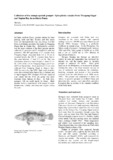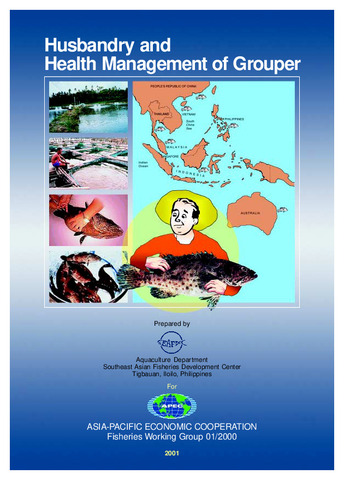Assessment of grouper resources around Zamboanga City and Basilan, Philippines
| dc.contributor.author | Lasola, N. T. | |
| dc.contributor.author | Samson, R. A. | |
| dc.contributor.author | Domingo, P. B. | |
| dc.contributor.editor | Bagarinao, Teodora | |
| dc.date.accessioned | 2018-03-13T04:02:10Z | |
| dc.date.available | 2018-03-13T04:02:10Z | |
| dc.date.issued | 2007 | |
| dc.identifier.citation | Lasola, N. T., Samson, R. A., & Domingo, P. B. (2007). Assessment of grouper resources around Zamboanga City and Basilan, Philippines. In T. U. Bagarinao (Ed.), Research Output of the Fisheries Sector Program (Vol. 2. Reports on Fisheries and Aquaculture, pp. 105-108). Quezon City, Philippines: Bureau of Agricultural Research, Department of Agriculture. | en |
| dc.identifier.isbn | 9718511776 | |
| dc.identifier.uri | http://hdl.handle.net/10862/3275 | |
| dc.description.abstract | A total of 2,643 kg of groupers were collected from six markets (96% of the biomass) and from prescribed fish traps in three fishing grounds (106 kg, 4%) around Zamboanga City and Basilan from November 1993 to October 1994. The collection included 26 species in seven genera: Aethaloperca, Cephalopholis, Cromileptis, Epinephelus, Niphon, Plectropomus, and Variola. The three species of highest biomass were Epinephelus fasciatus (26%), Cephalopholis sonnerati (14%) and Cromileptis altivelis (13%). The least biomass was contributed by Epinephelus sexfasciatus (0.1%), Plectropomus areolatus (0.1%), and Cephalopholis sexmaculatus (0.3%). Grouper biomass was lower from November to April and greater from May to October. Groupers caught by the prescribed fish traps were mostly Epinephelus merra (50% of the total). The highest catch of grouper was 0.8 kg/fish trap around Sta. Cruz Island in July, and the highest catch of all demersal fishes was 7 kg/trap around Malamawi Island in September. On average, groupers made up less than 10% of the monthly catch of fish traps. The groupers collected from the markets and from the fish traps averaged 28 cm in total length— all young juveniles. Cromileptes altivelis (average 38 cm) were the largest individuals and Plectropomus spp. (36 cm) similarly so. The largest C. altivelis (1.5 kg) was caught in December and the smallest (0.8 kg) in April and August. The various Cephalopholis species averaged 31 cm, and the various Epinephelus species were smallest at 26 cm. Groupers were largest in December and smallest between January and May. Length-weight equations were derived for seven grouper species. Of the 78 grouper stomachs that were dissected, 52 were empty and 26 contained food, mainly crabs, anchovies, hermit crabs, soldierfish, squids, and shrimps. Groupers with mature and ripe varies had from 3,000 to 11,000 eggs per gram ovary. | en |
| dc.language.iso | en | en |
| dc.publisher | Bureau of Agricultural Research, Department of Agriculture | en |
| dc.subject | groupers | en |
| dc.subject | Epinephelus | en |
| dc.subject | Epinephelus fasciatus | en |
| dc.subject | Cephalopholis sonnerati | en |
| dc.subject | Cromileptes altivelis | en |
| dc.subject | Epinephelus sexfasciatus | en |
| dc.subject | Plectropomus areolatus | en |
| dc.subject | Cephalopholis sexmaculata | en |
| dc.subject | Philippines | en |
| dc.title | Assessment of grouper resources around Zamboanga City and Basilan, Philippines | en |
| dc.type | Book chapter | en |
| dc.citation.spage | 105 | |
| dc.citation.epage | 108 | |
| dc.citation.bookTitle | Research Output of the Fisheries Sector Program | en |
| dc.subject.asfa | percoid fisheries | en |
| dc.subject.asfa | fisheries | en |
| dc.subject.asfa | catch-effort | en |
| dc.subject.asfa | biomass | en |
| dc.subject.asfa | fishing grounds | en |
| dc.subject.asfa | trap nets | en |
| dc.subject.asfa | seasonal distribution | en |
| dc.subject.asfa | population number | en |
| dc.subject.asfa | length-weight relationships | en |
| dc.subject.asfa | stomach content | en |
| dc.subject.asfa | sexual maturity | en |
| dc.subject.asfa | fecundity | en |
このアイテムのファイル
| ファイル | サイズ | フォーマット | 閲覧 |
|---|---|---|---|
|
このアイテムに関連するファイルは存在しません。 |
|||



